The Best Knee Brace for Bone on Bone Pain
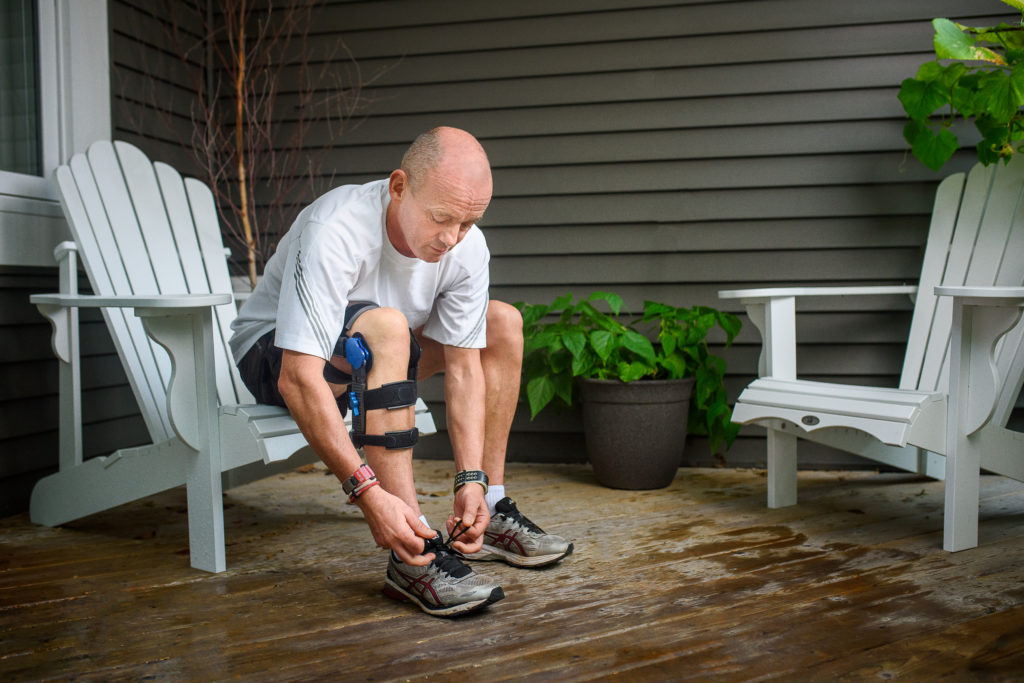
Bone on bone contact is one of the main causes of pain and discomfort among those with knee osteoarthritis. Depending on the severity, it can limit your ability to exercise and stay active. It can even make daily movements like walking, climbing stairs, or getting up from a chair quite difficult. Knee braces are one treatment option that can help reduce bone on bone pain so you can get back to doing what you love. Some knee braces are better for treating osteoarthritis than others. In this article, we’ll cover different bracing solutions to help you find the best knee brace for bone on bone pain.
What You Need to Know
Severity and Location
Bone on bone contact in the knee usually occurs in the later stages of osteoarthritis (OA). At this point, there has been significant cartilage loss and joint space narrowing as a result of the disease. If you’ve been diagnosed with moderate or severe OA (Figure 1), then bone on bone contact is likely contributing to your pain, stiffness, and other symptoms.
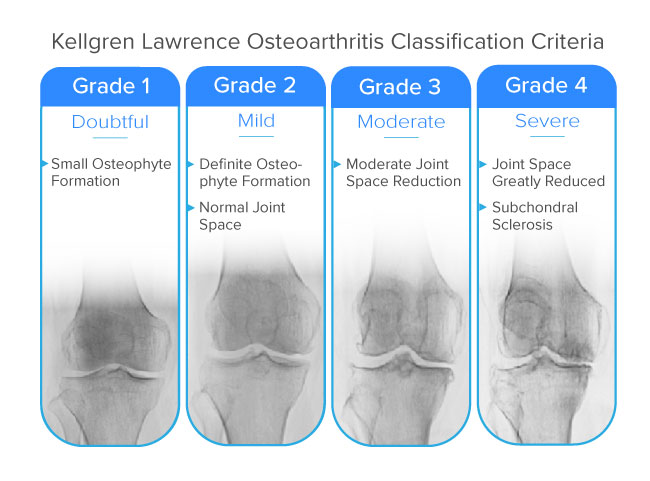
Osteoarthritis can cause bone on bone pain in one or multiple compartments of the knee where bones meet. It’s important to know which knee compartments are affected before choosing a knee brace. This is because some braces can only reduce bone on bone contact in specific compartments, so they are only useful for certain people.
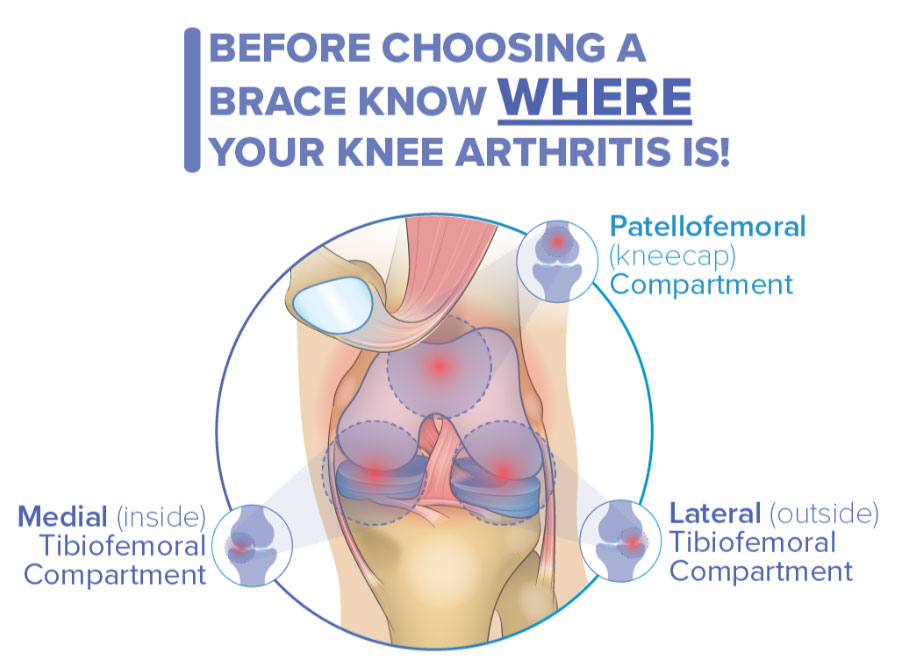
If you want more in-depth information about osteoarthritis and bone on bone knee pain, we highly recommend checking out the resources below:
How a Knee Brace Can Reduce Bone on Bone Pain
Forces in the knee can increase to several times body weight during certain activities, such as squatting or climbing stairs. If your knee is bone on bone, putting that kind of pressure on the damaged joint surfaces will probably be very painful. To combat this, most OA knee braces are designed to offload the joint. Offloading reduces pressure on the joint surfaces. This allows the knee to move more freely with less bone on bone contact and friction. There are several ways a brace can do this, but the result is usually pain relief and improved mobility. Reducing bone one bone contact also helps protect against further damage.
Individuals who wear an offloader knee brace for bone on bone pain can often feel the benefits right away. Improvements in technology in recent years make braces an increasingly viable treatment option, especially for those looking to delay or avoid knee replacement surgery.
Types of Knee Brace for Bone on Bone
Once your knee osteoarthritis has progressed to the stage where there is bone on bone contact, you will likely benefit most from an offloader brace. These braces are designed to address moderate to severe osteoarthritis specifically. There are two main types of offlaoders. Each works in a different way to relieve bone on bone contact and pain.
Uni-compartment Offloader Braces
Conventional offloader braces are called uni-compartment offloaders because they reduce bone on bone contact in one side (or tibiofemoral compartment) of your knee. They shift pressure to the other side of the knee where the cartilage is still intact and there is still space between the bones (Figure 2). This helps to relieve pain during exercise or daily activities that involve bending the knee.

The major limitation of uni-compartment offloaders is that they can only help a small subset of osteoarthritis patients. Just 3-20% of OA patients have damage in one tibiofemoral compartment, while at least 80% have damage in multiple compartments or under the kneecap.1,2 As a result, uni-compartment offloaders can’t meet the needs of many people suffering from bone on bone knee pain.
Tri-compartment Offloader Braces
A tri-compartment offloader (TCO) is a new type of brace that addresses the limitations of uni-compartment offloaders. As you might guess from the name, a TCO is designed to offload all three knee compartments at once. This means the brace can reduce bone on bone contact in both sides of the knee and under the kneecap (Figure 3). As a result, TCOs can help almost anyone suffering from bone on bone knee pain, regardless of location.
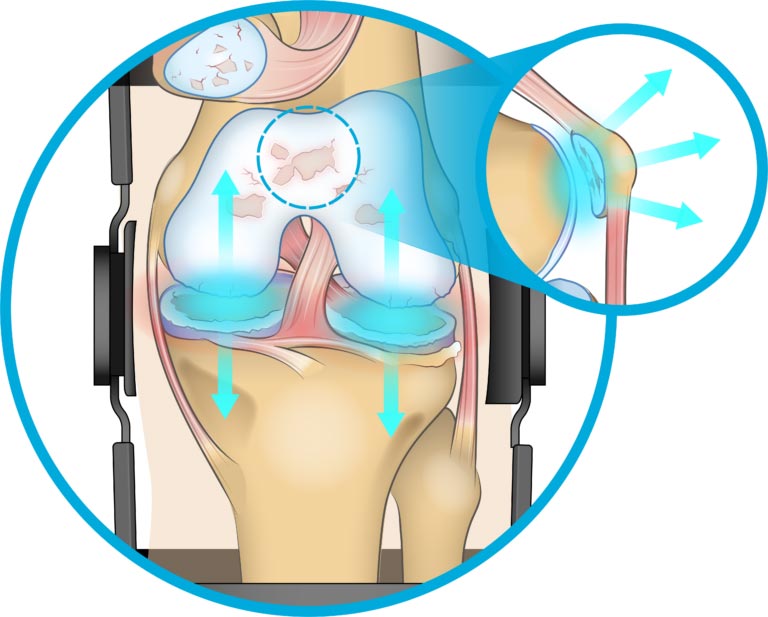
A TCO brace uses a specialized hinge to absorb body weight when you bend your knee. This reduces the force going through the joint, which reduces bone on bone contact. When you straighten your leg, the hinge returns the energy it absorbed to help power your leg muscles along the way. Overall, the brace works similarly to a shock absorption system on a car or bike. The combination of force reduction and knee extension assist allows for pain-free movement and enhanced mobility and muscle strength.
Choosing the Best Knee Brace for Bone on Bone Pain
Depending on where you’re experiencing bone on bone contact and pain, different types of offloader knee brace will be best for you.
When to Choose a Uni-compartment Offloader
If you have osteoarthritis and bone on bone knee pain in one tibiofemoral compartment of your knee, then a uni-compartment offloader brace is a great choice. Typically, if you have this pattern of OA you only experience pain on one side of your knee. Using an offloader to shift pressure away from the painful side will likely reduce bone on bone contact and relieve many of your symptoms. These braces are also cost-effective and minimally invasive, making them a great alternative to surgery. Most people experience improvements in pain and other symptoms after wearing one.3,4 Pictured below are some of the best offloaders.
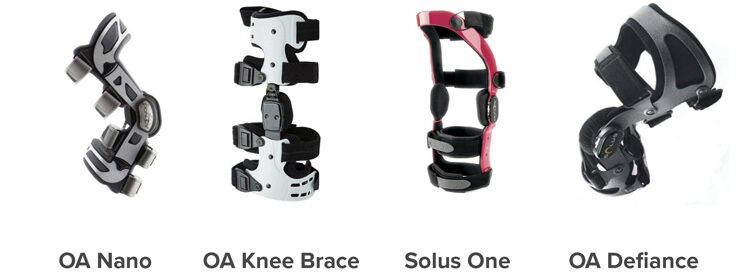
Keep in mind that to relieve bone on bone contact in one part of the knee, offloader braces shift pressure to other parts of the knee. This can increase stress on other compartments, which over time could lead to osteoarthritis and bone on bone pain.
When to Choose a Tri-compartment Offloader
In many cases, a tri-compartment offloader (TCO) is better suited to relieve bone on bone pain than a uni-compartment offloader. If you have osteoarthritis and bone on bone knee pain under your knee cap or in multiple compartments of your knee, then a TCO offloader is likely the best brace for you and can provide significant pain relief and mobility improvements.
Patellofemoral OA
If you experience pain on the front of your knee (under the knee cap), especially during activities like stair climbing, then it could indicate you have OA in the patellofemoral compartment. Damage to this compartment is quite common and is associated with worse symptoms10. A TCO is the only brace capable of offloading this compartment to provide relief from bone on bone pain.
Multicompartmental OA
The more advanced your OA, the higher the likelihood that you will have damage in multiple knee compartments. If you have OA in multiple compartments you’ll likely experience more severe symptoms10, especially during activities where the knee is bent and supporting body weight (crouching or squatting, getting up from sitting, going up or down stairs, walking uphill, or playing sports). A TCO is the only bracing solution that can offload the entire knee at once, reducing bone on bone pain in all three knee compartments.
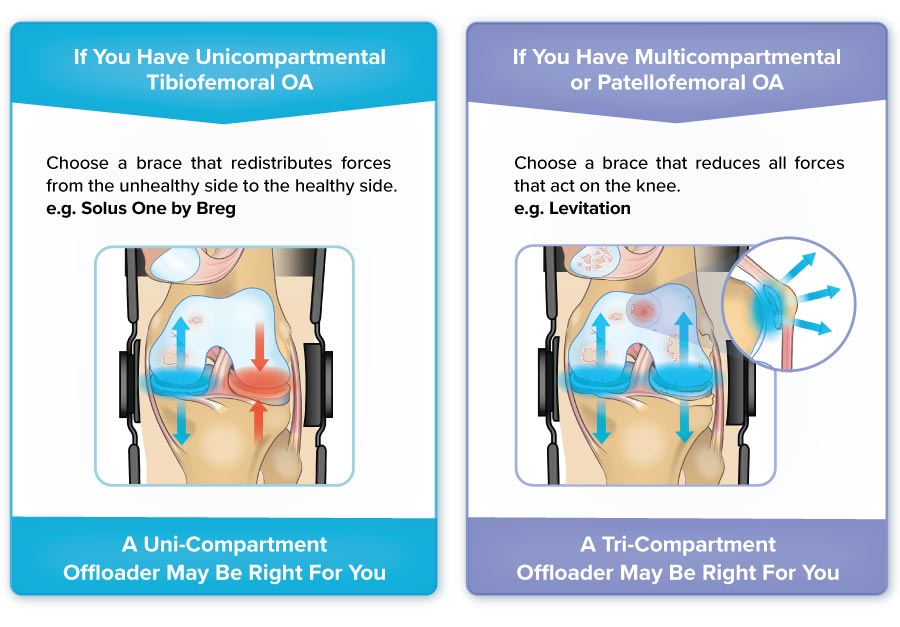
If you want more information on how to choose the right knee brace, check out this guide for everything you need to know.
The Benefits of a Tri-compartment Offloader
A TCO has the added benefit of knee extension assist, something not found in uni-compartment offloaders. Lots of people with severe OA find many forms of exercise too painful due to bone on bone contact. As a result, they become less active and gradually lose muscle strength. The hinge in a TCO brace works to power the leg muscles when you straighten your leg, so you can start to regain strength and become more active. Quadricep muscle strength is a key determinant of pain severity and function in those with OA,5 so as you get stronger your symptoms may improve as well.
The table below compares the features of some of the best offloader braces on the market. Notice that the tri-compartment offloader (Levitation 2) is the only brace that provides total pressure relief, rapid pain relief when squatting, kneeling, and lunging, and helps to increase knee strength. These unique features make a tri-compartment offloader a better option for most people with OA and bone on bone pain.
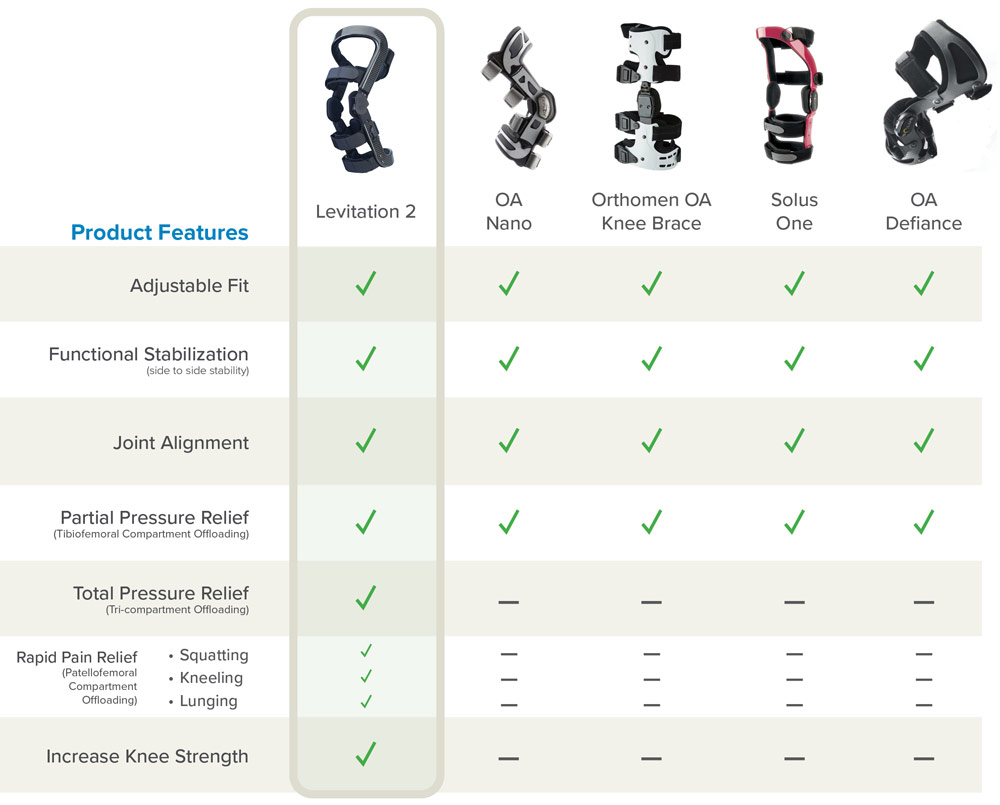
You can find more detailed comparisons of offloader braces in the articles listed below:
Levitation – A New Knee Brace for Bone on Bone Pain

Spring Loaded Technology’s Levitation 2 is the world’s first tri-compartment offloader. It is one of the best knee braces for bone on bone knee pain, especially if your knee is bone on bone in multiple compartments or under the kneecap. By offloading all three knee compartments at once, Levitation can improve pain, mobility, and function like no other brace can.
Features
Levitation’s unique features make it an unparalleled solution for bone on bone knee pain and osteoarthritis treatment:
Total Pressure Relief
Levitation’s defining feature is its patented bionic hinge. The liquid spring absorbs force when you bend your knee, then returns that energy to assist with leg extension. This allows the brace to reduce joint forces in all three knee compartments by over 40%,6 which decreases bone on bone contact.
Rapid Pain Relief
By reducing bone on bone contact in the knee joint, Levitation can immediately relieve pain symptoms caused by OA. If you have a misalignment of the knee, the optional pneumatic offloader can be added to Levitation to realign the knee. This further reduces pain and improves strength and stability.
Added Power
Levitation’s bionic hinge assists knee extension, powering your leg muscles so you can be active for longer. As your strength increases and pain decreases, the amount of assistance can be adjusted or turned off altogether.
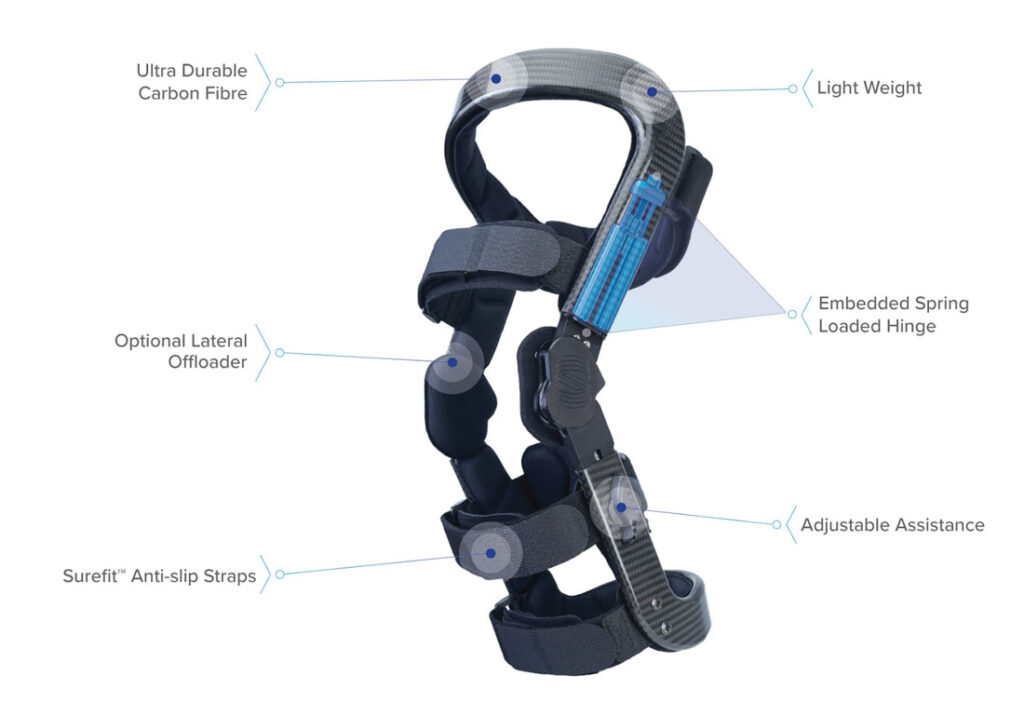
Clinical Benefits
Weight Loss
Levitation reduces joint forces in the knee to a level that is equivalent to losing 45 lbs of body weight.7 For most individuals, this is over 20% of their total body weight. Research shows that a 10% weight reduction translates to clinically meaningful improvements in OA symptoms. The best results are seen in those who lose more than 20% of their body weight.8 Putting on Levitation can provide the benefits of weight loss immediately since wearing it is equivalent to taking 45 lbs of body weight off of your knee. For comparison, this is 7.5 times the offloading power of the next best knee extension assist brace.7
Pain Relief
In a systematic survey of Levitation users with OA, 95% reported a significant decrease in pain symptoms after using the brace.9 Additionally, 85% of Levitation brace users experience mobility improvements and 86% report an improvement in their quality of life.
Return to Play
With less bone on bone pain, you may be able to start exercising more and return to the activities you love. On average, Levitation users can increase their physical activity levels by 8 hours per week.9 Exercising regularly is an excellent way to improve OA symptoms and keep your knees (and the rest of your body) healthy. If you’re looking to lose weight, wearing Levitation can help you maintain the exercise levels needed to reach your goal, without being limited by pain.
Learn More
We hope this information helped narrow down your search for the best knee brace for bone on bone pain. Before making a final decision, we recommend you have a conversation with your doctor or other healthcare professional. Ask for their advice on which knee brace is right for you.
Levitation can be a great choice to help you combat bone on bone knee pain. Check out the video below to see how the brace works. If you’re interested in Levitation and want to learn more, we encourage you to check out the resources below or visit our website.
The cost of Levitation is covered by most insurance providers. The brace also comes with a 30-day risk-free trial. You can learn more about pricing and insurance coverage here.
If you think Levitation might be the best knee brace for you, please feel free to contact a bracing specialist by clicking the button below.
References
- Heekin, R. D. and Fokin, A. A. (2014). Incidence of bicompartmental osteoarthritis in patients undergoing total and unicompartmental knee arthroplasty: is the time ripe for a less radical treatment? J. Knee Surg. 27(1): 77–82.
- Shahid, M. K., Al-Obaedi, O., & Shah, M. (2018). Prevalence of compartmental osteoarthritis of the knee in an adult patient population: A retrospective observational study. EC Orthopaedics, 9(10), 774–780.
- Richard Steadman, J., Briggs, K. K., Pomeroy, S. M., & Wijdicks, C. A. (2014). Current state of offloading braces for knee osteoarthritis. Knee Surgery, Sports Traumatology, Arthroscopy, 24(1), 42-50.
- Gohal, C., Shanmugaraj, A., Tate, P., Horner, N. S., Bedi, A., Adili, A., & Khan, M. (2018). Effectiveness of valgus offloading knee braces in the treatment of medial compartment knee osteoarthritis: A systematic review. Sports Health: A Multidisciplinary Approach, 10(6), 500-514.
- Hinman, R. S., & Crossley, K. M. (2007). Patellofemoral joint osteoarthritis: An important subgroup of knee osteoarthritis. Rheumatology, 46(7), 1057-1062.
- McGibbon, C.A., Brandon, S., Bishop, E.L., Cowper-Smith, C.D., and Biden, E. (2020). Biomechanical study of a tricompartmental offloader brace for patellofemoral or multicompartment knee osteoarthritis. Frontiers in Bioengineering and Biotechnology, 8.
- Budarick, A.R., MacKeil, B. E., Fitzgerald, S., and Cowper-Smith, C.D. (2020). Design evaluation of a novel multicompartment offloader knee brace. Journal of Biomechanical Engineering, 142(1).
- Messier, S.P., Resnik, A.E., Beavers, D.P., Mihalko, S.L., Miller, G.D., Nicklas, B.J., DeVita, P., Hunter, D.J., Lyles, M.F., Eckstein, F., Guermazi, A., and Loeser, R. F. (2018) Intentional Weight Loss in Overweight and Obese Patients With Knee Osteoarthritis: Is More Better? Arthritis Care Res. (Hobokin). 70(11): 1569–1575.
- Budarick, A.R., Bishop, E.L., and Cowper-Smith, C.D. (2020). Preliminary evaluation of a new orthotic for multicompartment knee osteoarthritis: a retrospective pilot survey. Journal of Prosthetics and Orthotics. Under Peer Review.
- Hart, H. F., Crossley, K. M., & Hunt, M. A. (2017). Gait patterns, symptoms, and function in patients with isolated tibiofemoral osteoarthritis and combined tibiofemoral and patellofemoral osteoarthritis. Journal of Orthopaedic Research, 36(6), 1666–1672.